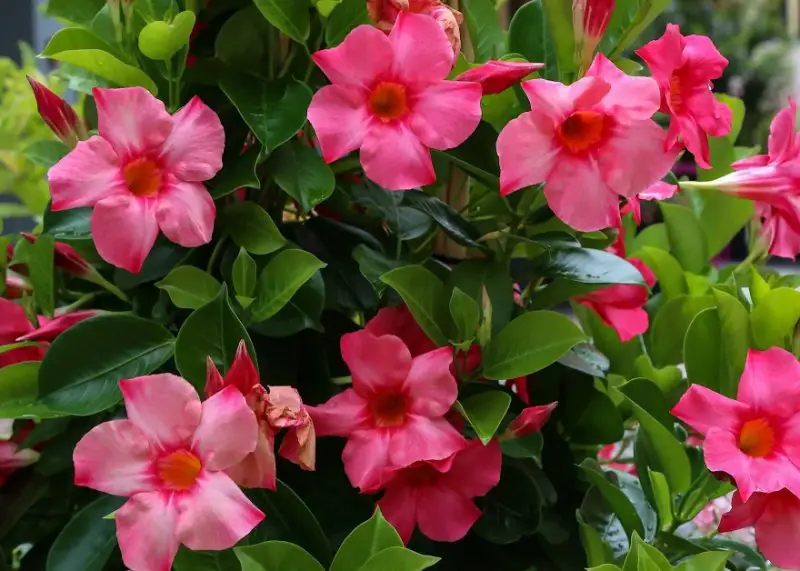If you’re looking to add a touch of vibrant color to your garden or patio, the Dipladenia plant (often referred to as Mandevilla) is an excellent choice. Known for its stunning trumpet-shaped flowers and glossy green leaves, Dipladenia has become a favorite among gardeners and plant enthusiasts alike.
This comprehensive guide will explore everything you need to know about Dipladenia care, ensuring that your plants thrive and bloom beautifully.
Understanding Dipladenia: An Overview
What is Dipladenia?

Dipladenia is a genus of flowering plants in the Apocynaceae family, native to Central and South America. The plant is known for its vigorous growth and ability to produce an abundance of large, colorful flowers throughout the summer. The most popular species include Dipladenia sanderi, which features bright pink flowers, and Dipladenia boliviensis, known for its white blooms.
Key Characteristics of Dipladenia
- Botanical Name: Dipladenia spp.
- Common Names: Mandevilla, Dipladenia
- Family: Apocynaceae
- Mature Size: Can grow up to 4-10 feet tall, depending on the variety
- Flower Color: Pink, red, white, yellow
- Sun Exposure: Full sun to partial shade
- Soil Type: Well-draining, rich in organic matter
- Hardiness Zones: Generally zones 9-11
Essential Dipladenia Care Tips
Optimal Light Requirements
Understanding Sunlight Needs
Dipladenia thrives in full sun, meaning it requires at least 6 to 8 hours of direct sunlight daily to produce the vibrant flowers it is known for. While it can tolerate partial shade, less sunlight can lead to reduced flowering and leggy growth.
Tips for Providing Adequate Light
- Location Selection: Choose a spot in your garden or patio that receives ample sunlight throughout the day.
- Using Containers: If you’re growing Dipladenia in pots, consider moving them around to find the perfect sunny spot.
- Indoor Growth: If growing indoors, place your Dipladenia near a south or west-facing window for optimal light exposure.
Soil Composition: The Right Mix
Importance of Well-Draining Soil
The type of soil you use can significantly affect the health of your Dipladenia. These plants prefer well-draining soil rich in organic matter. Heavy or compacted soil can lead to root rot, so it’s essential to create the right conditions.
Recommended Soil Mix
For the best results, use a mixture of:
- Potting Soil: A high-quality potting mix designed for flowering plants.
- Perlite or Sand: To enhance drainage and aeration.
- Organic Matter: Such as compost or aged manure to provide essential nutrients.
Watering Guidelines for Healthy Growth
How to Water Dipladenia
Watering is a critical aspect of Dipladenia care. These plants prefer to dry out slightly between waterings, making it essential to monitor soil moisture carefully.
- Watering Frequency: Generally, water your Dipladenia once a week during the growing season (spring and summer). In fall and winter, reduce watering to every 2-3 weeks.
- Signs of Overwatering: Yellowing leaves and wilting can indicate overwatering, while drooping leaves may suggest underwatering.
- Best Practices: Always water deeply, allowing excess water to drain away. Ensure pots have drainage holes to prevent waterlogging.
Temperature and Humidity Requirements
Ideal Climate Conditions
Dipladenia prefers warm temperatures, thriving in conditions ranging from 65°F to 80°F (18°C to 27°C). It is not frost-tolerant, making it suitable for USDA zones 9-11.
Tips for Maintaining Optimal Conditions
- Protection from Cold: If you live in a cooler climate, bring your Dipladenia indoors during winter months or cover outdoor plants to protect them from frost.
- Humidity Levels: These plants enjoy humidity, so misting the leaves or placing a humidity tray nearby can help in dry environments.
Fertilization: Feeding Your Dipladenia
Importance of Regular Feeding
Fertilizing your Dipladenia is crucial for promoting healthy growth and abundant flowering. During the growing season, these plants require more nutrients to support their vibrant blooms.
Recommended Fertilization Schedule
- Type of Fertilizer: Use a balanced, water-soluble fertilizer with an NPK ratio of 10-10-10 or similar.
- Feeding Frequency: Fertilize every 4-6 weeks during the growing season (spring and summer). Reduce or stop fertilization in fall and winter when the plant enters dormancy.
- Application Tips: Always follow the manufacturer’s instructions for application rates and methods to avoid over-fertilizing.
Pruning and Maintenance
The Importance of Pruning
Pruning is essential for maintaining the shape and health of your Dipladenia. It encourages bushier growth, removes dead or diseased wood, and can help improve air circulation.
When and How to Prune
- Best Time to Prune: Prune your Dipladenia in early spring before new growth begins. This timing ensures that you can shape the plant without disrupting its flowering cycle.
- Pruning Techniques: Use clean, sharp pruning shears to make cuts just above a leaf node. Remove any dead or damaged stems and thin out crowded areas to improve airflow.
Pests and Diseases: Prevention and Treatment
Common Pests Affecting Dipladenia
While Dipladenia is relatively resistant to pests, it can still attract a few common offenders, including:
- Aphids: Small, green insects that can cause leaf curling.
- Spider Mites: Tiny pests that thrive in dry conditions and can lead to stippled leaves.
- Mealybugs: White, cottony pests that can weaken the plant if left unchecked.
Treatment Options
- Insecticidal Soap: A natural solution to treat most pest infestations.
- Neem Oil: An effective organic pesticide that can help control a variety of pests.
- Regular Inspections: Check your plants frequently for signs of pests or disease to catch any issues early.
Common Diseases and Their Prevention
Dipladenia is susceptible to a few diseases, primarily due to improper care. The most common issues include:
- Root Rot: Often caused by overwatering and poor drainage.
- Fungal Infections: Can occur in overly humid conditions.
Prevention Strategies
- Proper Watering: Allow the top inch of soil to dry out between waterings to prevent root rot.
- Good Air Circulation: Ensure your Dipladenia is not overcrowded with other plants to improve airflow.
- Avoid Overhead Watering: Water the base of the plant instead of the leaves to minimize fungal issues.
Propagation: Growing New Dipladenia Plants
How to Propagate Dipladenia
If you love your Dipladenia and want to expand your collection, propagation is relatively straightforward. The most common method is through stem cuttings.
Steps for Successful Propagation
- Select a Healthy Stem: Choose a stem that is 4-6 inches long with at least 2-3 sets of leaves.
- Make the Cut: Use clean, sharp scissors to cut just below a leaf node.
- Prepare the Cutting: Remove the lower leaves to expose the nodes and promote root growth.
- Rooting Process: Place the cutting in water or a potting mix with good drainage. Keep it in a warm, bright spot out of direct sunlight.
- Monitor for Growth: In a few weeks, roots should develop. Once they are a few inches long, transplant the cutting into its own pot.
Frequently Asked Questions (FAQs) About Dipladenia Care
Can Dipladenia Be Grown Indoors?
Yes, Dipladenia can be grown indoors as long as it receives sufficient light. A south-facing window is ideal for providing the necessary sunlight.
How Often Should I Water Dipladenia?
Water your Dipladenia when the top inch of soil feels dry, typically once a week during the growing season.
What Should I Do If My Dipladenia Isn’t Blooming?
If your Dipladenia isn’t blooming, it may not be getting enough light. Ensure it receives at least 6-8 hours of direct sunlight daily.
Conclusion: Mastering Dipladenia Care
Caring for Dipladenia plants can be a fulfilling endeavor, as their stunning flowers and lush foliage add beauty and vibrancy to any space. By following the tips outlined in this guide, including providing adequate sunlight, maintaining well-draining soil, and regularly watering and fertilizing, you can enjoy a thriving Dipladenia plant for years to come.
With a little patience and care, your Dipladenia will reward you with breathtaking blooms that will surely be the envy of your neighbors. Embrace the beauty of this tropical plant, and let it flourish in your garden or home!






